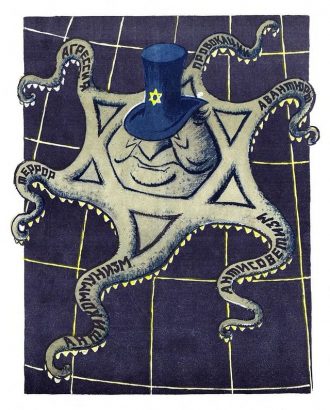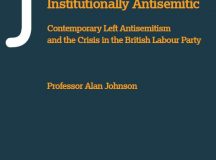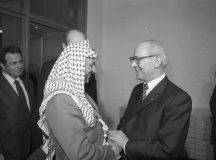For many decades, virulently antisemitic forms of ‘anti-Zionism’ were central to the cold war propaganda of the Communist states. In this powerful essay Izabella Tabarovsky not only lays bare the entire shameful story of Soviet Judeophobia but shows us that, to quote William Faulkner, ‘the past is not dead, it is not even past’. ‘This essay is also available in Polish.
Introduction
In 1985, the KGB-supervised Anti-Zionist Committee of the Soviet Public, known by its Russian acronym as AKSO, issued a brochure, Criminal Alliance of Zionism and Nazism.[i] The brochure reported on a press conference that the Committee had held some months earlier. The site for the press conference, the press center of the Soviet Ministry of Foreign Affairs, indicated the official blessing of the messages AKSO had to deliver. The brochure was translated into English and distributed abroad by Novosti Press Agency, a news service and an important arm of Soviet foreign propaganda.
A propagandistic document reporting on a propagandistic event, the brochure painted a harrowing picture of Zionism. Senior members of the AKSO, most of whom were prominent Soviet Jews (an intentional choice on the part of the KGB, meant to deflect accusations of antisemitism) claimed that they had irrefutable proof of Zionist co-operation with the Nazis. They described Zionists as facilitators of Nazi expansionism, accused them of falsely inflating the significance of antisemitism and Jewish victimhood in World War II, and claimed that the 1930s agreement that permitted the transfer of 60,000 German Jews to Palestine had made it ‘easier for the Nazis to unleash World War II.’ They claimed that Zionists had colluded ‘in the genocide against the “Slavs, Jews and some other peoples of Europe”.’ Speakers concluded by rejecting, in advance, any attempts by ‘pro-Zionist press’ to represent the committee’s assertions as antisemitic; disassociated Zionists from Jews; and promised that Zionism would never succeed in repudiating the ‘historical reality’ of cooperation between the Zionists and the Nazis.
The brochure might have read as a shocking smear that distorted history had it not been an integral part of a massive Soviet anti-Zionist campaign that entered a particularly active stage in 1967. Its language reflects its epoch – one marked by Cold War tensions, propagandistic jargon that permeated all aspects of Soviet public life, and virulent demonisation of Israel and Zionism. Alleged Zionist-Nazi collaboration and false equivalence between the two were among the campaign’s centerpieces.
Designed by the KGB and overseen by chief Communist Party ideologues, the campaign had achieved numerous successes. For a significant portion of domestic and some foreign audiences, it succeeded at emptying Zionism of its meaning as a national liberation movement of the Jewish people and associating it instead with racism, fascism, Nazism, genocide, imperialism, colonialism, militarism and apartheid. It contributed to the adoption of the notorious 1975 UN General Assembly Resolution 3379, which held Zionism to be a form of racism and paved the way for the demonisation of Israel within that organisation.
In the course of the campaign, hundreds of anti-Zionist and anti-Israel books and thousands of articles were published in the USSR, with millions of copies entering circulation in the country. Many were translated into foreign languages – English, French, German, Spanish, Arabic and numerous others. In 1970 alone, the comparison between alleged Zionist and Nazi racism – just one of the campaign’s numerous memes – merited 96 mentions (Pinkus 1989:256). Demonisation of Zionism continued in films, lectures, and radio broadcasts. Anti-Zionist cartoons, many of an obvious antisemitic nature, were a regular feature of Soviet publications.
The campaign used the significant Soviet broadcasting and publishing capacity abroad, as well as front organisations and friendly communist and other radical left organisations in the West and third world countries to transmit its messages to foreign audiences. The U.S. State Department viewed the AKSO committee as an important tool within that campaign, one that it classified as a tool in the Soviet arsenal of ‘active measures’ – ‘covert or deceptive operations conducted in support of Soviet foreign policy.’
The antisemitic nature of this campaign was appalling. The main authors contributing content– many of whom had direct links with the KGB and top party leadership – relied heavily on antisemitic tropes borrowed directly from the Protocols of the Elders of Zion. Some in the group were closet admirers of Hitler and Nazism and used Mein Kampf as both a source of ‘information’ about Zionism and inspiration for their own interpretations.
The Soviets vehemently rejected accusations of antisemitism, arguing that they were ‘Zionist tricks’ and ‘nefarious imperialist scheming.’ But some 2.6 million Soviet Jews knew better. In 1976, during one of the peaks of the campaign, the Soviet Jewish activist Natan Sharansky said that he sensed ‘the smell of pogrom’ in the air.
Virulently antisemitic anti-Zionism that was so central to the late Soviet Union’s propaganda seems to have faded from the West’s collective memory. Yet, in a strange case of déjà vu for those who, like myself, have lived through the late Soviet anti-Zionist campaign or have studied it in detail, the same memes and ideas that were in use then continue to circulate in contemporary far-left anti-Zionist circles.
Political cartoons equating Israel with Nazi Germany that might as well have been lifted from Soviet newspapers have appeared on mainstream progressive blogs. One-time London mayor and prominent member of the Labor party Ken Livingstone has claimed that ‘Hitler was supporting Zionism before he went mad and ended up killing six million Jews.’ Lenni Brenner’s 1983 anti-Zionist classic Zionism in the Age of the Dictators is built around supposed Nazi-Zionist equivalency. References to Zionism and Israel as racist, imperialist, colonial, genocidal and apartheid abound in contemporary far-left discourse. The anti-Zionist discourse of the UK Labour Party, which is part and parcel of its current crisis over antisemitism, is replete with the same memes.
The similarity begs the question of the ideological origins of this discourse. Just as it is important to understand the ideological heritage of the far-right’s antisemitic rhetoric, it is important to wrap our heads around the origins of the far-left’s anti-Zionist discourse, particularly where it intersects with antisemitism. We can begin by re-examining what historian Jeffrey Herf calls ‘the toxic ideological brew’ that the communist anti-Zionist and anti-Israel campaigns left behind (Herf 2016, p. 461).
‘International Zionism’ as a worldwide conspiracy to destroy socialism and spread imperialism
The idea of Zionism as a hostile ideology began to solidify in the post-World War II USSR in the late 1940s, once it became clear that Israel was aligning itself with the ‘imperialist camp’ rather than the Soviet Union. Allegations of Zionist conspiracy became a prominent feature of Stalinist purge trials. The Slansky Trial in particular featured the idea of ‘international Zionism’ as a worldwide conspiracy aiming to destroy socialism. Manufactured by the Soviet secret services, the trial tied together Zionism, Israel, Jewish leaders, and American imperialism, turning ‘Zionism’ and ‘Zionist’ into dangerous labels that could be used against one’s political enemies. The trial opened the door to vicious antisemitism.
Over the following decade, the Soviet press continued a broad anti-Israel campaign. It received an extra boost with the trial of Adolf Eichmann in Jerusalem. The Soviets were determined to undermine the legitimacy of the trial, whose emphasis on the Holocaust challenged their concept of Slavic victimhood in World War II. One way to do so was to attack Israel’s diplomatic relationship with West Germany, which the Soviets painted as a ‘fascist’ heir of Nazi Germany.
The ‘obvious’ conclusion was that Zionism was a natural bedfellow with fascists and Nazis. Drawing this parallel allowed the Soviets to tap into a visceral sentiment. For the Soviet people, whose sacrifice in World War II was enormous, fascism and Nazism represented the greatest evil imaginable. By equalising Zionism with these two, Soviet propaganda architects sought to create a visceral reaction – of a kind that didn’t depend on fact but on a deep feeling.
By the 1960s, the Soviets’ anti-Zionist propaganda arsenal widened courtesy of a book, Judaism without Embellishments by Trofim Kichko. A deeply antisemitic tract featuring Der Stürmer-like cartoons, it proposed that Judaism, with its concept of Jews as a chosen people, was an inherently racist religion and linked to American imperialism and Israeli colonialism. One of the cartoons showed a stereotypical Jewish capitalist licking a boot with a swastika painted on it.
The book initially generated a storm of indignation, including from foreign leftist groups, and the Soviets disavowed it – but only temporarily. In the following years, Kichko became one of the key authors contributing to the massive volume of anti-Zionist propaganda.
Beside the ongoing advancement of the alleged Nazi-Zionist connection, his book introduced an idea that Soviet propagandists would use repeatedly in the coming decades: that Zionism was an outgrowth of Judaism and as such asserted Jewish racial superiority. The Soviets would use this line repeatedly over the years, including at the UN, as they worked toward the adoption of the ‘Zionism Is Racism’ resolution.
The Turning Point: The Six-Day War of 1967
It was the Arab-Israeli war of 1967, however, that really intensified Soviet anti-Zionist campaigning. For Moscow, which had supported the Arab forces, the war was a crushing defeat, handing a clear ideological victory to the ‘imperialist’ camp. At home, Israel’s victory served as the catalyst for a national awakening among Soviet Jews. All of a sudden, the old enemy – international Zionism and its Jewish fifth column at home – seemed to be rearing its head. A new propaganda tool was needed to help shape public opinion at home and abroad.
On August 7, 1967, an article titled ‘What Is Zionism?’ appeared simultaneously in several Soviet publications. Its author, Yuri Ivanov, an employee of the KGB and Central Committee apparatus who would go on to become one of the leading Soviet anti-Zionist writers, took his clue from age-old tropes of Jewish conspiracy and influence: he presented Zionism as a centrally-controlled international system that gripped the entirety of global politics, finance and the media, had unlimited resources, and sought to establish monopolistic control over the entire world.
Similar articles followed, including one by Kichko, now back in favor. In 1968 he produced a new book, Judaism and Zionism. Building on his original ideas, he blamed Judaism for the ‘crimes’ of Israeli ‘aggressors.’ ‘There is a direct connection between the morality of Judaism and the actions of the Israeli Zionists,’ wrote Kichko. ‘Weren’t the actions of the Israeli extremists during their latest aggression against the Arab countries in keeping with the Torah?’
Kichko’s book was one of many Soviet publications that attempted to show that the evils of Zionism could be traced back to Judaism. Judaism had always been the bête noir of the Soviet struggle against religion, and it was persecuted with particular harshness. Even as a few synagogues continued to function into the 1970s and 1980s, the study of Hebrew was prohibited, and so was the training of the next generation of clergy, indicating that the Soviet leadership had clearly marked Judaism for extinction. The problem was that to paint every aspect of Jewish religion and tradition in black, rendered Soviet claims that they were not antisemitic but simply anti-Zionist, meaningless.
Next in the line of prominent Soviet anti-Zionist texts came Ivanov’s Caution: Zionism! The state-owned press greeted the 1969 book with rave reviews. The initial 70,000 print run was followed by three additional re-printings. Moving into the early years of the 1970s, hundreds of thousands of copies were put into circulation. The book was translated into sixteen languages and became one of Soviet anti-Zionism’s foundational texts. It described Zionists as representative of colonialist-imperialist powers, hostile toward the working people of Palestine and cultivating an insatiable thirst for power. It portrayed Judaism as the world’s most inhuman religion, one that had spawned the world’s most vicious nationalism. The supposed connection between Zionism and fascism received detailed treatment, as did the idea that ‘Israeli militarism and West German neo-Nazism are fed from the same source.’
Like Kichko before him, Ivanov devoted ample space to detailing Judaism’s idea of Jews as a ‘chosen people,’ which, he showed, demonstrated the supposedly racist underpinnings of Zionism. He also took time to discredit the idea of a single Jewish nation. He called the idea a Zionist invention that was ‘false and reactionary in content’: this notion, he claimed, had prevented Jews from comfortably assimilating into their host nations, promoted a ghetto mentality, kept the Jews separate, and consequently provoked antisemitism.
Some of these ideas could be traced back to the early Bolshevik discourse on the Jewish question, but in the new environment, they had a new purpose. With Ivanov’s book, the Soviet ideologists were sending their Jewish citizens a clear message: assimilate or be viewed as adherents of the most racist, reactionary, and genocidal religion and ideology on the planet—and suffer the consequences.
The book came out at a crucial time. The Six Day War led to a national awakening among Soviet Jews. Growing awareness of the tragedy of the Holocaust (the Soviets had sought to internally suppress information, in particular, about the Jewish aspects of Hitler’s war) was strengthening the Soviet Jewry’s Jewish identity. As the Soviet regime’s antisemitic rhetoric intensified, more Soviet Jews began to reach out to the United States and Israel for help. Arrests and trials on charges of Zionist activity began. In 1970, a group of 16 refuseniks attempted to hijack an empty plane to fly it to freedom. They were arrested before they even got to the plane. The harsh sentences that the group received – including two death sentences, later commuted as a result of an international outcry – drew attention abroad to their plight. The campaign for Soviet Jewry began to gather steam in the West.
Inside the country, the increasingly antisemitic anti-Zionist campaign continued unabated. Ivanov and Kichko were among a dozen or so primary anti-Zionist ideologues who throughout the campaign’s twenty year span produced some fifty books, with nine million copies in circulation, propagating ‘paranoid, conspiratorial anti-Zionism mixed with antisemitic, xenophobic, and ultra-nationalist messages, combined with anti-capitalist and anti-Western rhetoric,’ wrote historian Andreas Umland. Titles included Fascism under a Blue Star, which compared Zionism to fascism; De-Zionization (this one was translated into Arabic and published in Syria in 1979 on Hafez al-Assad’s direction); and Zionism and Apartheid, a deeply antisemitic tractate whose author was a fan of Nazi ideology and borrowed for his writings directly from Mein Kampf.
Soviet Jewry and the Nazi Analogy
In 1983, two new books from the same genre received international attention thanks to the US Jewish organisations engaged in the campaign for Soviet Jewry. One was called On the Course of Aggression and Fascism. It detailed Zionism’s alleged ‘criminal alliance with the Fascists’ and blamed the Zionists for the extermination of non-Zionist Jews during the Holocaust. The second, titled The Class Essence of Zionism, declared Jews a ‘fifth column in any country.’ The two books were written by a notorious antisemite with a doctoral degree Lev Korneev and must have been so egregious as to prompt an unexpected act of personal protest by a non-Jewish Soviet scholar. In the oppressive climate of the early 1980s USSR, it’s doubtful if anyone followed in his steps.
Each book publication spawned endless reviews and ‘analytical pieces’ aimed at different audiences, including the military, party functionaries, trade unions, and youth. The Academy played an important role in lending legitimacy to the effort through its ‘scholarly’ articles. Reporting on this output, the Washington Post observed in 1979: ‘Soviet bureaucrats vehemently reject suggestions that “anti-Zionism” means “anti-Semitism.” But to many Soviet Jews, it is a distinction without a difference.’
The campaign did not rely on printed word alone. The Soviets produced several documentaries to support the campaign. One was called The Concealed and the Apparent: Goals and Actions of the Zionists. With its manipulation of historical footage, deeply antisemitic imagery, and parallels between Zionism and Nazism, it was deemed so inflammatory as to be limited to selected audiences. Although it was never released to the broader public, the film, which is today available online, serves as a stark visual testimony to the deep connections between Soviet-style anti-Zionism and antisemitism.
What drove this campaign was the Soviets’ apparent belief that a vast Zionist conspiracy did, in fact, exist, and that this campaign aimed at undermining the Soviet Union and socialism itself. The more the West criticised the Soviet human rights record and its treatment of its Jewish minority, and the more the Soviet Jewry expressed a demand to emigrate, the more the authorities felt confirmed in their belief, and the more the campaign intensified.
The authorities engaged numerous resources to discredit the very idea of emigration. They claimed that those who had done so experienced nothing but misery abroad and were begging to come back. For foreign audiences, the message was that discrimination against their Jewish citizens was fiction, and that Soviet Jews had no desire to leave their motherland. Geared at English-speaking foreign audiences in particular were English-language booklets, published by the same Novosti Publishing House that distributed other Soviet anti-Zionist propaganda abroad. Their titles spoke for themselves: Soviet Jews: Fact and Fiction; The Deceived Testify: Concerning the Plight of Immigrants in Israel; and Deceived by Zionism.
By the mid-1970s the KGB felt the Zionist threat was so acute that it warranted establishing a special department to focus specifically on Zionism. American Jewish organisations were viewed as a particularly important link in the presumed anti-Soviet Zionist conspiracy. The Soviets believed the international movement for Soviet Jewry to be a cynical manipulation manufactured from the top in order to give a black eye to the Soviet image abroad and meddle in the country’s domestic affairs. Countless articles were devoted to discrediting it. According to Israeli investigative journalist Ronen Bergman, the Soviet secret services targeted some of the organisations involved in the movement by discrediting them and attempting to sow discord and confusion.
By the early 1980s, US-Soviet relations were hitting a new low, and emigration demands were surging. The newly created Anti-Zionist Committee of the Soviet Public provided the much-needed propagandistic boost, producing brochures and delivering press conferences on the evils of Israel and Zionism, including for foreign audiences. In a 1983 Pravda article announcing the launch of the Committee, its members declared Zionism a concentration of ‘extreme nationalism, chauvinism, and racial intolerance, justification of territorial seizure and annexation, armed adventurism, a cult of political arbitrariness and impunity, demagogy and ideological sabotage, sordid maneuvers and perfidy.’ A 1985 TASS broadcast commenting on one of the committee’s English-language brochures announced: ‘Zionist leaders are responsible for the deaths of thousands of Jews annihilated by the Nazis. It is precisely the Zionists who assisted the Nazi butchers by helping them to make up the lists of the doomed inmates of ghettoes, escorting the latter to the places of extermination and convinced them to resign to the butchers.’
Global Political Warfare
The Soviets didn’t limit themselves to fighting Zionism within their borders. An enemy such as this one had to be fought on multiple fronts, including through information warfare abroad. Here at their disposal was a powerful state-owned media apparatus whose goal was to ‘spread the truth about the USSR in all the continents’ (Hazan 2017, p. 49). It published numerous newspapers and magazines with a combined circulation of tens of millions of copies per year in English, German, Spanish, Hindi, French, Arabic, and other languages. Radio Moscow broadcast more than 1,000 hours per week, in eighty languages, to Europe, the Middle East, North and sub-Saharan Africa, and the Americas. The Soviet Union’s main foreign broadcasting arm and primary carrier of foreign propaganda, the Novosti Press Agency, worked in over 110 countries. One of its tasks was to build relations with the local press (Hazan 2017: 31, 34-61). Numerous friendship societies were established by the Soviets abroad as well as front organisations designed to promote Soviet international interests, mobilise sympathisers, and offer propaganda support (Hazan 2017: 103-14).
The Soviet relationships with the local media meant that they could rely on these outlets, whenever necessary, to inject prefabricated items of a propagandistic or disinformation nature into the global news stream. Novosti could then pick these up and disseminate them throughout their network (Hazan 2017: 49). It was in this way that the Soviets scored one of their biggest Cold War disinformation successes: getting the CBS television anchor Dan Rather to broadcast to millions of viewers a version of a KGB-fabricated story of American scientists inventing the AIDS virus to kill African-Americans and gay people.
The Soviets structured their foreign anti-Zionist messaging in accordance with their specific foreign policy priorities for that country or audience. ‘Zionism played a role of a bugaboo,’ Israeli historian Nati Cantorovich told me. ‘In Africa it was about South African apartheid and Zionism. In Latin America it was about American imperialism and Zionism. In Asia, it was Japanese revanchism and Zionism.’
In 1970, for example, Soviet Weekly, a Soviet English-language outlet that targeted the United Kingdom, reprinted, in four consecutive issues, an article that defined Zionism as ‘not so much the Jewish nationalist movement it used to be but an organic part of the international – primarily American – imperialist machinery for the carrying out of neocolonialist policies and ideological subversion’ (Hazan 2017: 150). In 1977 the same publication printed a piece titled ‘Why We Condemn Zionism,’ which proclaimed Zionism to be a racist doctrine and characterised Israelis as ‘worthy heirs to Hitler’s National-Socialism’ (Wistrich 2012: loc 5882). Several Africa programs, in English, French, and Portuguese, broadcast on the same day in 1973, claimed that Zionism had ‘an ideological affinity with South African racism’ and was ‘part of the global strategy of imperialism aimed against the liberation movements’ (Hazan 2017: 152).
Numerous Soviet anti-Zionist books were translated and distributed abroad. According to the Israeli investigative reporter, Bergman, the 1979 Soviet anti-Zionist tractate titled The White Book, was distributed to a variety of audiences in thirty-two countries, including US and Canadian Communist Party leaders, ‘parliament members, ministers and social activists from different countries, libraries, as well as representatives of international organisations, libraries, and higher education institutions.’ Among the English-language propaganda brochures published by Novosti were: Zionism: Instrument of Imperialist Reaction, Soviet Opinion on Events in the Middle East and the Adventures of International Zionism, and Anti-Sovietism – Profession of Zionists, Zionism Counts on Terror and others.
Senior members of the Anti-Zionist Committee of the Soviet Public regularly published articles in foreign press and addressed foreign audiences. The head of the committee, General David Dragunsky, took part in Soviet Hebrew-language broadcasts directed at Israel. In October 1983 he appeared on Radio Damascus to boast of the Committee’s successes and to claim that its anti-Zionist work was receiving broad support from outside the USSR, including from Israel. He ensured the audiences of the Committee’s close relationship with the Arab world and especially Syria. Syria was one of the most militantly anti-Zionist states in the Middle East, and the Soviet-Syrian friendship treaty of 1980 specifically named Zionism a common enemy. In conveying his anti-Zionist message to Syrian audiences, Dragunsky was lending a helping hand to Soviet foreign policy objectives vis-à-vis the country (Korey 1989:35).
Arab-language anti-Zionist literature was an important part of Soviet propaganda directed at the Middle East. According to Bergman, it served as source material for Mahmoud Abbas’s 1982 Ph.D. dissertation. In the early 1980s, Abbas was enrolled at Moscow’s Patrice Lumumba University, a school established to train future Third World elites in Marxism-Leninism and prepare them to become pro-Soviet influencers (Hazan 2017: 87-88). He defended his dissertation at Moscow’s Institute of Oriental Studies – an important institution within the Academy of Sciences, which regularly churned out ‘scholarly’ works demonizing Zionism and Israel. During Abbas’s tenure, the Institute was headed by Yevgeny Primakov, an Arabist with lifelong connections to Soviet intelligence in the Middle East, who would eventually head the Soviet foreign intelligence agency SVR. That Primakov personally appointed Abbas’s dissertation advisor shows the importance that the Soviet foreign policy and intelligence establishments attached to the educational output of this already prominent Palestinian leader.
Abbas’s dissertation was published as a book in 2011 in Arabic under the title The Other Side: The Secret Relationship between Nazism and Zionism. Several passages from the book reproduced in Bergman’s article, replicate some of the mainstays of the Soviet anti-Zionist campaign, including those concerning the alleged Zionist collaboration with the Nazis during the Holocaust and casting doubt on the number of Holocaust victims.
A particularly curious piece of historical falsification that made it into Abbas’s book concerned Adolf Eichmann’s capture by the Mossad. According to Bergman, Abbas wrote that the Mossad abducted Eichmann in order to prevent the high-ranking Nazi from revealing the secret of Zionists’ role in the Final Solution.
Strikingly, the very same piece of fabrication was employed by a member of the Anti-Zionist Committee of the Soviet Public at a press conference in Moscow in June 1983. At the event, Yuri Kolesnikov, author of numerous works demonising Zionism and Israel, claimed that during the war the Zionists were ‘in league with the Gestapo and SS’ and that the Israelis executed Eichmann years later ‘to prevent the “sacred secrets” of this collaboration from becoming public.’ The repetition of the same provocation by these two individuals, who shared a connection to Soviet propaganda and intelligence structures, shows that they were drawing on the same source for their anti-Zionist claims.
The Toxic Legacies of Soviet Antisemitic anti-Zionism
We have yet to understand fully how Soviet anti-Zionist propaganda influenced the world. In those individual instances where this influence is evident, it is apparent just how negatively it impacted the lives of Jews around the globe.
One instance of such influence is documented in Dave Rich’s book The Left’s Jewish Problem: Jeremy Corbyn, Israel and Anti-Semitism. Rich details how the adoption of the ‘Zionism Is Racism’ resolution by the UN – an effort the Soviets spent a decade promoting – opened the door for British Students’ Unions to restrict the activities and funding of Jewish societies on campuses or even ban them.
The logic was simple: the UN has ascertained that Zionism is racism; Jewish societies declare their support for Israel; ergo Jewish societies are racist and cannot be tolerated on campus. British Student Unions ‘mostly did this for honorable anti-racist reasons, but in doing so they discovered something disturbing,’ writes Rich. ‘When you use the “Zionism is racism” idea as the basis for practical politics, you can end up with an antisemitic campaign’ (Rich 2016).
In July 1990, less than a year before the USSR fell apart, Pravda published an editorial admitting to the wrongs of the anti-Zionist campaign of the previous quarter century. ‘Considerable damage was done by a group of authors who, while pretending to fight Zionism, began to resurrect many notions of the antisemitic propaganda of the Black Hundreds and of fascist origin’, it read. ‘Hiding under Marxist phraseology, they came out with coarse attacks on Jewish culture, on Judaism and on Jews in general.’ But the damage inflicted by the two decades of the campaign could not be undone with a single editorial. A 1990 Soviet poll showed that a significant percentage of Soviet citizens thought that Zionism was ‘the policy of establishing the world supremacy of Jews’ and an ‘ideology used to justify Israeli aggression in the Middle East.’
Among the organisations that had risen to prominence as perestroika lifted controls over civil society were the virulently anti-Semitic Pamyat (Memory) and Otechestvo (Homeland), which blended fascist and neo-Nazi ideas with a particular form of Russian ethnic ultranationalism. Some of their leaders were the same ideologues who had manufactured the Soviet anti-Zionist campaign. In the summer of 1988, as the Russian Orthodox Church prepared to celebrate the millennium of Christianity, rumors of impending pogroms sent the country’s Jews into panic. Two million Jews left the country in the following decade.
Conclusion: ‘Wherever and whenever they employed anti-Zionism for their political purposes, antisemitism blossomed’
One of the lessons that the late Soviet anti-Zionist campaign teaches is that anti-Zionism and antisemitism have historically been deeply and, possibly, inextricably intertwined. True to their ideological tenets, the Soviets never attacked the Jews in purely racist terms. Accused of antisemitism, they indignantly claimed that they were simply anti-Zionist. But wherever and whenever they employed anti-Zionism for their political purposes, antisemitism blossomed.
Examples of other countries further prove this point. Poland’s 1968 anti-Zionist campaign quickly degenerated into an antisemitic witch-hunt, resulting in expulsions and forced emigration of some 15,000 Jews. A recent investigation into the US Women’s March revealed crude antisemitism hiding behind its leaders’ anti-Zionist rhetoric. UK Labour’s overt anti-Zionism has been revealed – including most recently by this publication – to have been a cover for vulgar, racist antisemitic sentiments.
Today, as some of the leading opinion-makers on the left are seeking to build consensus around the idea that anti-Zionism and antisemitism are not the same, understanding this history is vitally important. As I have written elsewhere, claiming that anti-Zionism and antisemitism are not the same may make for an interesting intellectual exercise. What happens in practice is another matter.
At its core, the Soviet anti-Zionist campaign of 1967-1988 was a campaign of propaganda and disinformation. It built and weaponised narratives based on made-up or twisted facts. It distorted history. It employed classic propaganda tools such as deception, guilt by association, and repetition to inculcate the key messages. It shamelessly played on people’s sentiments, and it used both Soviet Jews and Muslims as instruments of propaganda (Hazan 2017: 230-93).
Despite its claims, the Soviet anti-Zionist campaign was hardly motivated by a search for justice, peace or liberation for the Palestinian people. Conceived by master propagandists, it was an instrument whose purpose was to divert attention, manipulate, solidify control, purge enemies, and broaden influence for one of the most oppressive regimes in humanity’s history.
A particular trick of Soviet anti-Zionism, according to the Israeli historian Kiril Feferman, was that it ‘proposed a version of antisemitism to Western audiences that did not have obvious antisemitic overtones.’ It did so by substituting anti-Zionism for antisemitism in its propaganda, which made it passable for the many well-intentioned, idealistic individuals who otherwise would have recoiled in disgust from this rhetoric. Yet, underneath the relatively benign covers, the messages of the campaign packed a powerful antisemitic charge.
The messaging emanating from today’s far-left anti-Zionist camp is strikingly similar to the messaging of the Soviet anti-Zionist campaigns. From the claims of Zionist collaboration with the Nazis in the Holocaust, to the idea of Zionism as an inherently racist and oppressive ideology, to the concept of Israel as a settler-colonialist state that engages in genocidal behavior and apartheid – all of these ideas were part and parcel of the Soviet anti-Zionist narrative.
More research is needed to shed light on the trajectory and impact of the ideas that the late Soviet anti-Zionist campaign brought forth. Soviet anti-Zionism borrowed from the tsarist Protocols and Hitler’s Nazi propaganda; it adapted those ideas to its Marxist-Leninist framework; and ended up fertilising the ideologies of post-Soviet Russian ultranationalism. Did its ideological precepts also influence the global left and its view of Zionism and Israel? If so, to what extent? Is it possible that some of those ideas have outlived the system that produced them? To answer these questions is to find a crucial missing link in our understanding of contemporary left antisemitism.
Bibliography
Cantorovich, Nati 2007, ‘Soviet Reactions to the Eichmann Trial: A Preliminary Investigation 1960 –1965’. Yad Vashem Studies 35:2, 103-141.
Frankel, Jonathan 1972, The Anti-Zionist Press Campaigns in the USSR 1969-1971: Political Implications, Jerusalem: Hebrew University of Jerusalem, Soviet and East European Research Centre.
Friedgut, Theodore H., Friedgut 1984, ‘Soviet anti-Zionism and Antisemitism – another cycle’, Soviet Jewish Affairs, 14:1, 3-22
Gjerde, Asmund Borgen 2018, ‘The logic of anti-Zionism: Soviet elites in the aftermath of the Six-Day War’, Patterns of Prejudice, 52: 271-92.
Hazan, Baruch A. 2017, Soviet Propaganda: A Case Study of the Middle East Conflict, New York: Routledge [1976, Keter Publishing House Jerusalem Ltd.].
Herf, Jeffrey 2009, Nazi Propaganda for the Arab World, New Haven & London: Yale University Press.
Herf, Jeffrey 2016, Undeclared Wars with Israel: East Germany and the West German Far Left, 1967-1989, New York: Cambridge University Press.
Korey, William 2013, Russian Antisemitism, Pamyat, and the Demonology of Zionism, New York: Routledge [1995, Harwood Academic Press]
Korey, William 1989, ‘The Soviet Public Anti-Zionist Committee: An Analysis’ in Soviet Jewry in the 1980s: The Politics of Anti-Semitism and Emigration and the Dynamics of Resettlement, edited by Freedman, Robert O., London: Duke University Press.
Lipstadt, Deborah 2011, The Eichmann Trial, New York: Schocken.
Pinkus, Benjamin 1989, The Jews of the Soviet Union: The History of a National Minority, Cambridge: Cambridge University Press.
Rich, Dave 2016, The Left’s Jewish Problem: Jeremy Corbyn, Israel and Anti-Semitism, Biteback Publishing.
Shnirelman, Victor 2012, Russkoye rodnoveriye: neoyazychestvo i natsionalism v sovremennoi Rossii, St. Andrew Biblical-Theological Institute.
Wistrich, Robert 2012, From Ambivalence to Betrayal: the Left, the Jews, and Israel, Kindle Edition, Lincoln and London: University of Nebraska Press (Kindle Edition)
Umland, Andreas 1999, ‘Soviet Antisemitism after Stalin’, East European Jewish Affairs, 29:1-2, 159-168.








































probably you can add antisemitic activities in eastern European countries participially in Polanad expulsion striped of citizenship of ~15000 jews .
Thank you for your fine article. You did not, however, cite a foundational work in this field, Paul Lendvai’s Anti-Semitism in Eastern Europe (1972). Lendvai demonstrated that the language of Soviet-bloc anti-Zionist anti-Semitism drew directly from the work of former Nazi journalists in the DDR. In other words, there is a direct historical link between Nazi ideology and the anti-Zionism of today’s “progressives.”